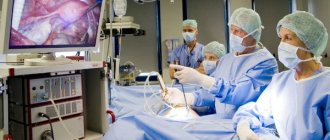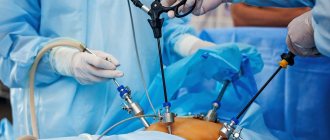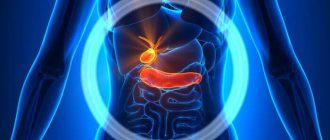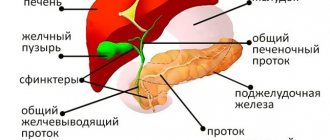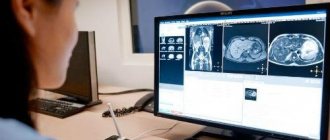Laparoscopy is a modern method of surgical intervention using endovideo equipment. This is a surgical approach technique that allows you to “look” into the abdominal cavity and pelvis through small incisions or punctures through the use of a system of special instruments.
Laparoscopic operations are mainly performed on the pelvic and abdominal organs. This method of treatment can significantly minimize the risks of any complications. Operations are carried out using special instruments and various types of energy (electricity, ultrasound, argon, etc.).
Indications for laparoscopy
- Infertility: allows you to identify and eliminate common physiological disorders that prevent pregnancy (for example, obstruction of the fallopian tubes).
- Severe forms of secondary dysmenorrhea - surgical intervention during laparoscopy can significantly improve the patient’s condition.
- Diseases of the internal genital organs - allows you to identify the presence of diseases such as uterine fibroids, ovarian cysts, endometriosis and a number of others.
- Suspicions of acute surgical and gynecological diseases - ectopic pregnancy, etc. In the latter case, with the help of laparoscopy, it is possible to preserve the fallopian tubes, which allows the woman to retain the ability to conceive and bear a child.
- Since laparoscopy is a surgical procedure, as part of the preoperative preparation the patient undergoes a wide range of tests and undergoes a number of examinations.
Diet before gallbladder removal surgery
To reduce the functional load on the liver and the structure of the hepatobiliary system, a special diet is required before removing the gallbladder ; it includes following several recommendations:
- Refusal to eat fried, fatty foods (especially those containing animal fats), pickles, marinades, and mushrooms.
- Avoid drinking alcohol, including low-alcohol drinks.
- Fractional meals, small portions, at least 5 times a day.
2-3 days before the proposed surgical intervention, exclude foods that can contribute to increased gas formation in the intestines (coarse plant fiber, brown bread, legumes, kvass).
Progress of the operation
Laparoscopic operations are performed exclusively under anesthesia (endotracheal). A linear incision of up to 1 cm is made in the area near the navel, a trocar (a port for a laparoscope) is inserted into the abdominal cavity, and the abdominal cavity is filled with carbon dioxide for better visualization and ease of operation with manipulators. Then, a laparoscope, a long tube equipped with a camera and light, is inserted into the abdominal cavity through the trocar, and the image is displayed on a monitor in front of the surgeon. The abdominal cavity and small pelvis are examined - the camera has a very high resolution and provides an overview of the organs from almost all sides, which allows the surgeon to reliably determine the location and nature of the pathological process. Next, in the lower part of the abdomen (the location of the remaining trocars is different in different operations), on the right, left and center, more small incisions are made in the skin (0.5 cm) and trocars for surgical instruments are installed. The necessary surgical intervention is carried out; the instruments in the ports are a kind of extension of the surgeon’s hands. After the operation is completed, the instruments are removed along with the ports, and the wounds for the ports are closed with cosmetic sutures.
A few hours after the operation, the patient is recommended to get out of bed to activate the circulatory system. Light food and drink are allowed. Given the minimal trauma of the operation, the patient can be discharged after 1–2 days.
What tests are done before gallbladder removal?
On the eve of the surgical intervention, the doctor prescribes a number of tests that must be taken without fail, regardless of the nature and extent of the operation, these include:
- Clinical analysis of blood and urine.
- Biochemical blood test with determination of liver samples.
- Fibrogastroduodenoscopy for visual examination of the mucous membrane of the esophagus, stomach, duodenum.
- Ultrasound examination of the abdominal organs.
- ELISA (enzyme-linked immunosorbent assay) of blood, which is used to determine antibodies to the causative agents of viral hepatitis and syphilis.
- Fluorographic examination of the respiratory and lung organs.
- Cardiogram (functional study of the heart condition).
All these tests before surgery to remove the gallbladder in the first surgical department of the hospital can be performed in one day, and the results and their interpretation will be known the next morning.
Recommendations before diagnostic hysteroscopy
- Stop sexual intercourse two days before hysteroscopy.
- The day before the procedure, cut or shave the pubic hair, labia and perineum short.
- On the eve of the intervention, go to bed no later than 22:00. You can take a sedative: tinctures of motherwort, peony, valerian, etc., according to the instructions included with the medications.
- In the morning, on the day of the procedure, take a shower and thoroughly clean the external genitalia, and put on clean knitted underwear.
- Hunger - last meal three hours before hysteroscopy.
- Immediately before the procedure, empty your bladder.
- HAVE WITH YOU:
- Referral for hysteroscopy, examination results (ultrasound, smear for flora, RW, HIV, Hepatitis B and C).
- A clean shirt (robe) and socks, sanitary pads, slippers.
Leave jewelry (earrings, rings, etc.) at home.
Back to contents
Conversation with a doctor.
The attending physician always talks with the patient before surgery. He will tell you about the surgical intervention, why it is necessary to perform it, and talk about the possible risks and complications of the procedure. Try to prepare your questions in advance so that the doctor can answer them during the conversation. Also, on the eve of the operation, the anesthesiologist conducts a conversation with the patient about the upcoming operation and anesthesia.
Advantages of the method
Laparoscopy in Yeisk has been actively developing in recent decades, more and more doctors are mastering this method and more and more medical institutions can provide such services. In cases where there is a choice between traditional open surgery and a minimally invasive laparoscopic method, both the doctor and the patient will prefer the second. And there are several good reasons for this.
- The operation itself is much less traumatic for the patient, since it requires only a few punctures.
- There is less chance of infection during and after surgery.
- Significantly shorter postoperative recovery period.
- Less chance of adhesions forming.
- Does not require a long stay in the clinic.
- After the operation, only a few barely noticeable scars remain at the puncture sites.
Why you need to prepare for hysteroscopy
With any surgical procedure, including office hysteroscopy, there is a risk of infection. During intrauterine intervention, this is due to the following:
- The so-called cervical barrier is broken. The penetration of microbes into the uterine cavity is prevented by the peculiarities of the anatomical structure of the cervix and the mucous contents in its canal - the “mucus plug”.
- During intrauterine intervention, the mucous membrane, the endometrium, is removed from the walls of the uterine cavity. An extensive wound surface is formed, which is an “entry gate” for microorganisms.
- The proliferation of microorganisms is facilitated by an excellent nutrient medium - blood.
Surgery is a stressful situation for the patient, and stress always causes a weakening of the body's defenses. Considering all of the above, I strongly recommend following your doctor's orders. This will prevent the risk of complications.
In addition to a special examination, medication may be prescribed. The purpose of such preparation is to protect the woman’s body as much as possible from possible complications, both during the operation and in the postoperative period.
Back to contents
An important part of preparing for hernia surgery is a consultation. During the consultation, the surgeon examines you in a standing and lying position, the presence or absence of a hernia, indications and contraindications for surgery are discussed, if necessary, the date of the operation is set and the most preferred hernioplasty technique is determined. During the consultation, the patient receives information about the procedure for performing the operation. It is important to review the risks associated with performing the surgery and discuss the healing process after hernia surgery and how it should progress. Depending on the scope of the operation and the general condition of the patient, the question of the method of pain relief (anesthesia, local, spinal anesthesia) is decided.
Preoperative examination plan. — Complete blood count — Blood group, Rh factor — Blood test for sugar — Biochemical blood test: — Total protein, bilirubin – general, etc., inc. - ASAT, AlAT, rest. nitrogen, creatinine, urea - Na+, K+ - Amylase, alkaline phosphatase - Coagulogram - Blood test for RW and ELISA, markers of viral hepatitis - General urine test - ECG (electrocardiogram with interpretation) - X-ray or FLG org. chest - Examination by a therapist (conclusion on the absence of contraindications to surgical treatment) - Examination by a gynecologist, urologist - Spirogram - Ultrasound of the heart
Before surgery to repair a hernia. Before surgery to eliminate a hernia, regardless of its size, it is necessary to undergo tests and undergo all necessary examinations. Before surgery to repair a hernia, it is advisable to take multivitamins and eat well, eating enough meat, fruits and vegetables. In the preoperative period, it is important to identify all concomitant diseases. Why is this necessary? Firstly, simultaneous (simultaneous correction) of diseases requiring surgical treatment is possible. For example, you can simultaneously remove an ovarian cyst, gallbladder and perform hernioplasty. Secondly, an in-depth preoperative examination will identify all risk factors that can complicate the course of the postoperative period and correct them in a timely manner. For extensive and giant hernias, in the preoperative period, special compression therapy is prescribed, aimed at training the body's systems and organs to the point where the internal organs from the hernial sac will be inserted into the abdominal cavity and create a condition called intra-abdominal hypertension syndrome. When the intestines and omentum are repositioned into the abdominal cavity from the hernial sac, the increased volume of internal organs puts pressure on the diaphragm, thereby reducing respiratory function and on the veins of the abdominal cavity, leading to its deposition in the lower extremities, thereby reducing venous return to the heart and cardiac output. All these changes are observed in cases of extensive and giant hernias and can be prevented by rational compression preparation. Your doctor, whom you yourself have chosen for your operation, will tell you in detail how to carry it out. It is extremely important to treat constipation and intestinal dysbiosis in the preoperative period. If problems with the intestines are not eliminated, bloating in the early postoperative period will lead not only to pain associated with overstretching of surgical sutures, but also to a number of other complications. Constipation, pulmonary diseases accompanied by cough, prostate adenoma must be corrected, since tension in the muscles of the abdominal wall will create all the conditions for a recurrence of the hernia. Competent preoperative preparation is of particular importance in patients with extensive and giant hernias, recurrent hernias in obesity, and diabetes mellitus. Considering the presence of concomitant somatic diseases in almost all such patients, we recommend including in the preoperative preparation algorithm the following therapeutic measures that directly affect the identified and correctable risk factors: 1. Breathing exercises, physical therapy, bronchodilators, a set of measures that improve broncho-alveolar drainage 2. Perioperative prescription of selective beta-blockers, mainly affecting the NO 3 system. Normalization of metabolic processes (metformin, thioctacid, thyroxine) 4. A course of rheotropic and vascular therapy (Detralex, Antistax, Wessel Duef) 5. A course of HBO therapy (1.7 atm , 45 min, 10 – 14 procedures while taking antioxidants) 6. Sanitation of foci of chronic infection 7. Correction of intestinal dysbiocenosis 8. Compression therapy As a rule, before surgery, the intestines are cleansed using an enema. It should be especially noted that the surgical field is shaved not the day before, but immediately before the operation.
